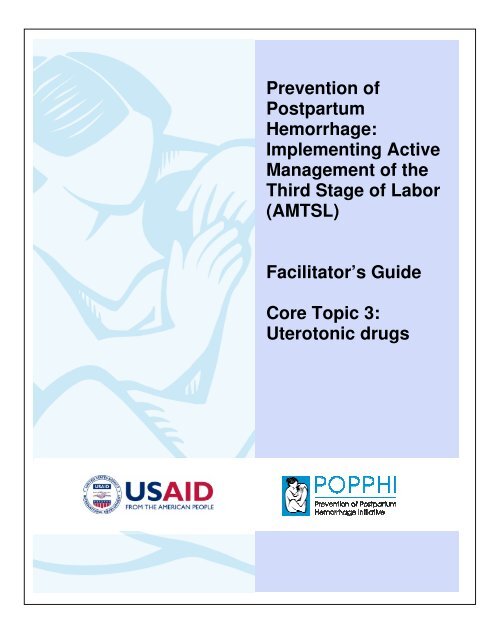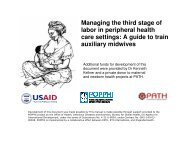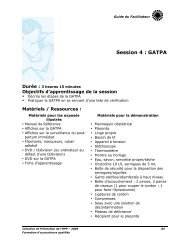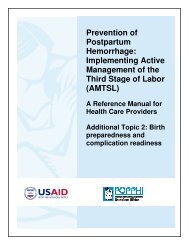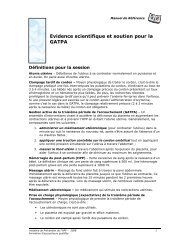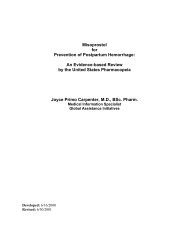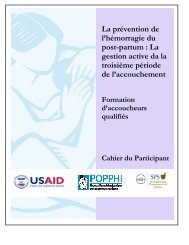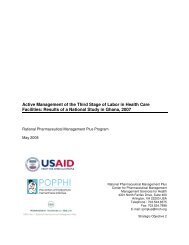AMTSL - POPPHI
AMTSL - POPPHI
AMTSL - POPPHI
Create successful ePaper yourself
Turn your PDF publications into a flip-book with our unique Google optimized e-Paper software.
Prevention of<br />
Postpartum<br />
Hemorrhage:<br />
Implementing Active<br />
Management of the<br />
Third Stage of Labor<br />
(<strong>AMTSL</strong>)<br />
Facilitator’s Guide<br />
Core Topic 3:<br />
Uterotonic drugs
Table of contents<br />
Core Topic 3: Uterotonic Drugs ........................................................................ 3<br />
Summary ...........................................................................................................3<br />
Objectives ..........................................................................................................3<br />
Materials/resources needed for the session .............................................................3<br />
Facilitator’s notes ................................................................................................3<br />
Lesson Plan ........................................................................................................4<br />
ii<br />
Prevention of Postpartum Hemorrhage: Implementing Active Management of the Third Stage of Labor
Facilitator’s Guide<br />
Core Topic 3: Uterotonic Drugs<br />
90 min.<br />
Summary<br />
In this section, you will review and compare the main drugs used to stimulate uterine<br />
contractions during third stage. There will also be an overview of the stability, storage, and<br />
costs of uterotonic drugs.<br />
The injection of a uterotonic drug immediately after birth of the baby and before delivery<br />
of the placenta is one of the most important ways to prevent PPH. The most commonly<br />
used uterotonic drug, oxytocin, has proven to be very effective in both reducing the<br />
incidence of PPH and shortening the third stage of labor.<br />
Objectives<br />
By the end of this topic, participants will be able to:<br />
• Identify uterotonic drugs used in the third stage of labor.<br />
• Explain advantages/disadvantages of the four major uterotonic drugs.<br />
• Compare the stability of oxytocin and ergometrine in hot climates.<br />
• Explain at least three ways to store oxytocin to keep it effective.<br />
• Describe how to decide what uterotonic drug to use for <strong>AMTSL</strong>.<br />
Materials/resources needed for the session<br />
• Reference Manual, Participant’s Notebook, and Facilitator’s Guide.<br />
• Flipchart, flipchart stand, markers, and flipchart tape.<br />
Facilitator’s notes<br />
• This session contains detailed information on the major uterotonic drugs. Review the<br />
session content, especially regarding drug dosage/administration and storage to be<br />
sure that these correspond with country-specific or local guidelines. Adapt or revise<br />
information as needed.<br />
• Samples of the drugs used in your region may be useful as teaching aids (use expired<br />
drug vials, for example, or pictures of these vials or tablets).<br />
• Consider making separate handouts for each of the three drugs with detailed<br />
information from the chart. This may make the information easier to read and countryspecific<br />
information can be included.<br />
Prevention of Postpartum Hemorrhage: Implementing Active Management of the Third Stage of Labor 3
Lesson Plan<br />
Uterotonic drugs<br />
Name of presenter<br />
Prevention of Postpartum Hemorrhage Initiative<br />
(<strong>POPPHI</strong>) Project<br />
PATH<br />
4 Prevention of Postpartum Hemorrhage: Implementing Active Management of the Third Stage of Labor
Facilitator’s Guide<br />
Flipcharts / Overheads / PowerPoint slides 1 and 2<br />
Time: 5 min.<br />
Activity: Review objectives of the session.<br />
Objective: Present an overview of the session.<br />
Note to the facilitator:<br />
• Introduce the session by presenting the objectives: read the objectives, briefly<br />
summarize or ask a participant to read them aloud.<br />
Objectives<br />
CT3-1<br />
By the end of this topic, learners will be able to:<br />
• Identify uterotonic drugs used in the third<br />
stage of labor.<br />
• Explain advantages/disadvantages of the 4<br />
major uterotonic drugs.<br />
• Compare the stability of oxytocin and<br />
ergometrine in hot climates.<br />
• Explain at least 3 ways to store oxytocin to<br />
keep it effective.<br />
• Describe how to decide what uterotonic drug<br />
to use for <strong>AMTSL</strong>.<br />
Notes to the facilitator:<br />
• Begin the session by giving a clear definition of a uterotonic.<br />
• Ask participants if they have questions about the definition before continuing.<br />
Definition<br />
CT3-2<br />
• Uterotonics: substances that stimulate<br />
uterine contractions and increase uterine tone<br />
Prevention of Postpartum Hemorrhage: Implementing Active Management of the Third Stage of Labor 5
Flipcharts / Overheads / PowerPoint slides 3 and 4<br />
Time: 10 min.<br />
Activity: Brainstorming and discussion to review indications and dangers of administering<br />
uterotonic drugs during the intrapartum period.<br />
Objectives:<br />
• Review uses and contraindications for uterotonic drugs.<br />
• Review dangers of uterotonic drug abuse.<br />
Brainstorming<br />
CT3-3<br />
How are uterotonics used in the antepartum<br />
and intrapartum periods<br />
Notes to the facilitator:<br />
• Ask participants to list<br />
potential uses of uterotonic<br />
drugs before the woman has<br />
given birth.<br />
• Write their answers on the<br />
flipchart. These may include<br />
cervical ripening, induction of<br />
labor, and augmentation of<br />
labor.<br />
Notes to the facilitator:<br />
• Ask participants to list potential dangers of uterotonic drugs when used before the<br />
woman has given birth.<br />
• Write their answers on the<br />
flipchart. These should<br />
include fetal distress,<br />
intrauterine fetal demise,<br />
and uterine rupture. In<br />
addition,<br />
induction/augmentation of<br />
labor contributes to<br />
uterine atony in the<br />
postpartum period.<br />
Brainstorming<br />
CT3-4<br />
What are potential dangers when using<br />
uterotonics in antepartum/intrapartum<br />
periods<br />
• Brainstorm ideas on how<br />
to prevent or minimize<br />
potential dangers of using<br />
uterotonic drugs in the<br />
antepartum/intrapartum<br />
periods. These may<br />
include: only<br />
induce/augment labor when all indications are met, only induce/augment labor in<br />
facilities where there is an operating theatre, carefully monitor maternal/fetal<br />
conditions when inducing/augmenting labor.<br />
6 Prevention of Postpartum Hemorrhage: Implementing Active Management of the Third Stage of Labor
Facilitator’s Guide<br />
Flipcharts / Overheads / PowerPoint slides 5 and 6<br />
Time: 5 min.<br />
Activity: Question-and-answer to review uterotonic drugs available in health facilities.<br />
Objectives:<br />
• Identify uterotonic drugs that participants are familiar with.<br />
• Link trade names of uterotonic drugs with their generic names.<br />
Notes to the facilitator:<br />
• Draw a table with five<br />
rows and two columns.<br />
Put titles on the<br />
columns: Trade Name<br />
and Generic Name.<br />
• Ask participants to<br />
brainstorm a list of<br />
uterotonic drugs used in<br />
their practice. As they<br />
list a uterotonic, write it<br />
in either the column<br />
“trade name” or “generic<br />
name.”<br />
• If a participant lists a<br />
uterotonic by the trade<br />
name, ask if participants<br />
know the generic name,<br />
and vice versa.<br />
List of Uterotonics<br />
Trade Name<br />
Generic Name<br />
CT3-5<br />
Notes to the facilitator:<br />
• Briefly review the trade and generic names for the uterotonic drugs most commonly<br />
used.<br />
List of Uterotonics<br />
CT3-6<br />
Trade Name<br />
Syntocinon® / Pitocin<br />
Methergine®<br />
Syntometrine®<br />
Misoprostol (Cytotec®)<br />
Generic Name<br />
Oxytocin<br />
Ergometrine<br />
Ergometrine + Oxytocin<br />
E1 analog prostaglandin<br />
Prevention of Postpartum Hemorrhage: Implementing Active Management of the Third Stage of Labor 7
Flipcharts / Overheads / PowerPoint slides 7 and 8<br />
Time: 15 min.<br />
Activity: Small group work to analyze characteristics of uterotonic drugs.<br />
Objective: Explain the advantages and disadvantages of uterotonic drugs used for <strong>AMTSL</strong>.<br />
Notes to the facilitator:<br />
• Ask participants to refer to the<br />
classroom learning activity #1 for<br />
Core Topic 3: Uterotonic Drugs in<br />
the Participant’s Notebook.<br />
• Ask participants to work in<br />
groups of two. Give them 2-3<br />
minutes to study Table 3.<br />
Uterotonic drugs for <strong>AMTSL</strong> in<br />
the Reference Manual. They<br />
should decide which of the<br />
uterotonic drugs:<br />
Works Works the the fastest.<br />
Has Has the the longest action.<br />
Causes tonic tonic contractions.<br />
Has Has a common side side effect effect of of<br />
shivering and and elevated temperature.<br />
Has Has a common side side effect effect of of<br />
headache.<br />
Is Is contraindicated in in women with with or or<br />
having history of of hypertension, heart heart<br />
disease, retained placenta, pre-<br />
pre-<br />
(1) works the fastest; (2) has the eclampsia, eclampsia.<br />
Has<br />
longest action; (3) causes tonic<br />
Has no no contraindications when when<br />
administered in in the the postpartum<br />
contractions; (4) has a common<br />
period.<br />
X<br />
side effect of shivering and<br />
elevated temperature; (5) has a common side effect of headache; (6) is<br />
contraindicated in women with or having history of hypertension, heart disease,<br />
retained placenta, preeclampsia, and eclampsia; (7) has no contraindications when<br />
administered in the postpartum period.<br />
Small Group Work<br />
Review of Uterotonics<br />
Find one partner to to work with.<br />
• Refer to to classroom learning activity 1 for Core<br />
Topic 3: 3: Uterotonic Drugs in in the Participant’s<br />
Notebook.<br />
• Answer the questions about uterotonics in in<br />
learning activity 1 by studying Table 3, 3,<br />
Uterotonic drugs for <strong>AMTSL</strong>, in in the<br />
Reference Manual.<br />
• Emphasize the following points:<br />
Answers<br />
CT3-8 CT3-8<br />
Oxytocin<br />
Ergometrine<br />
Misoprostol<br />
Notes to the facilitator:<br />
• After participants have had a<br />
chance to look through the<br />
table and answer the<br />
questions, call the group<br />
together. Read each sentence<br />
in the first column and ask<br />
participants to call out the<br />
answer. Put an “x” in the<br />
appropriate column.<br />
• Review drug<br />
action/effectiveness and side<br />
effects/cautions for each<br />
uterotonic drug.<br />
- If all injectable uterotonic drugs are available, skilled attendants should offer<br />
oxytocin to all women in preference to ergometrine/methylergometrine or oral<br />
misoprostol (600 mcg)<br />
- In the absence of <strong>AMTSL</strong>, a health worker trained in the use of a uterotonic drug<br />
(oxytocin or misoprostol) should offer use of a uterotonic without controlled cord<br />
traction to all women<br />
X<br />
X<br />
X<br />
X<br />
X<br />
CT3-7 CT3-7<br />
X<br />
8 Prevention of Postpartum Hemorrhage: Implementing Active Management of the Third Stage of Labor
Facilitator’s Guide<br />
Flipcharts / Overheads / PowerPoint slides 9 and 10<br />
Time: 10 min.<br />
Activity: Small group work to analyze the stability of uterotonic drugs when exposed to<br />
heat and light.<br />
Objective: Compare the stability of oxytocin and ergometrine in hot climates.<br />
Notes to the facilitator:<br />
• Ask participants to refer to<br />
classroom learning activity #2 for Small Group Work<br />
CT3-9 CT3-9<br />
Core Topic 3: Uterotonic Drugs in Review of uterotonics<br />
the Participant’s Notebook.<br />
• Find one partner to to work with.<br />
• Ask participants to work in groups<br />
of two. Give them 2–3 minutes to<br />
• Refer to to classroom learning activity 2 for Core<br />
Topic<br />
refer to the sections “Keeping<br />
3: 3: Uterotonic Drugs.<br />
uterotonic drugs effective” and<br />
• Answer the questions about stability of of<br />
“Tips to increase uterotonic drug<br />
uterotonics in in learning activity 2 by studying<br />
effectiveness” within Core Topic 3:<br />
sections Keeping uterotonic drugs effective<br />
and<br />
Uterotonic Drugs in the Reference<br />
Tips to to increase uterotonic drug<br />
effectiveness within Core Topic 3: 3: Uterotonic<br />
Manual. They should rank the<br />
Drugs in in the Reference Manual.<br />
uterotonic drugs by:<br />
- Their stability when exposed to<br />
heat. They should give a “1” to<br />
the most stable and a “3” to the least stable (misoprostol 1, oxytocin 2,<br />
ergometrine 3).<br />
- Their stability when exposed to light. They should give a “1” to the most stable<br />
and a “3” to the least stable (misoprostol 1, oxytocin 2, ergometrine 3).<br />
Notes to the facilitator:<br />
• After participants have had a chance<br />
to look through the table and answer<br />
the questions, call the group<br />
together. Read each sentence in the<br />
first column and ask participants to<br />
call out the answers. Write the rank<br />
number in the appropriate column.<br />
• Summarize this part of the session<br />
by emphasizing that while neither<br />
ergometrine nor oxytocin is stable<br />
when exposed to heat, oxytocin is<br />
much more stable than ergometrine<br />
when exposed to either heat or light.<br />
Answers<br />
Stability when<br />
exposed to to<br />
heat*<br />
Stability when<br />
exposed to to<br />
light*<br />
Oxytocin<br />
• Re-emphasize that while misoprostol is more stable than oxytocin, oxytocin is still<br />
the uterotonic of choice because of its effectiveness, action, lack of contraindications<br />
in the postpartum period, and cost.<br />
2<br />
2<br />
*Most stable: 1; 1; Least stable: 3<br />
Misoprostol<br />
1<br />
1<br />
Ergometrine<br />
3<br />
3<br />
CT3-10 CT3-10<br />
Prevention of Postpartum Hemorrhage: Implementing Active Management of the Third Stage of Labor 9
Flipchart / Overhead / PowerPoint slide 11<br />
Time: 30 min.<br />
Activity: Case studies to review storage of uterotonic drugs in different situations.<br />
Objective: Explain at least three ways to store oxytocin to keep it effective.<br />
Notes to the facilitator:<br />
• Divide participants into four<br />
groups to work on case studies.<br />
• Assign each group one of the four<br />
case studies found within the<br />
classroom learning activities for<br />
Core Topic 3: Uterotonic Drugs in<br />
the Participant’s Notebook.<br />
• Give each group 10 minutes to<br />
work through the case study,<br />
using Table 4, Recommended<br />
guidelines for transport and<br />
storage of uterotonic drugs, and<br />
the section “Tips to keep<br />
uterotonic drugs as effective as<br />
possible” in the Reference Manual as a guide.<br />
• After 10 minutes, bring all the groups together and ask each group to present their<br />
case study. Suggested answers can be found in the Participant’s Notebook and<br />
Facilitator’s Guide.<br />
• Facilitate a group discussion if there is controversy.<br />
Small Group Work<br />
Storage of uterotonics<br />
•• Divide into 4 groups to to work on on case studies found<br />
within the classroom learning activities for for Core Topic<br />
3: 3: Uterotonic Drugs in in the Participant’s Notebook.<br />
•• Group 1 – work on on case study #1; Group 2 – work on on<br />
case study #2; Group 3 – work on on case study #3;<br />
Group 4 – work on on case study #4.<br />
•• Each group has 10 10 minutes to to work through the case<br />
study. Use Table 4, 4, Recommended guidelines for for<br />
transport and storage of of uterotonic drugs, and the<br />
section Tips to to keep uterotonic drugs as as effective as as<br />
possible in in the Reference Manual for for guidance.<br />
• Summarize the case study exercise by emphasizing that importance or proper<br />
storage of uterotonic drugs.<br />
CT3-11 CT3-11<br />
Flipchart / Overhead / PowerPoint slide 12<br />
Time: 5 min.<br />
Activity: Group discussion to choose the most appropriate uterotonic for <strong>AMTSL</strong>.<br />
Objective: Describe how to decide what uterotonic drug to use for <strong>AMTSL</strong>.<br />
Notes to the facilitator:<br />
• Facilitate a discussion to decide<br />
which of the uterotonic drugs should<br />
be the uterotonic of choice for<br />
<strong>AMTSL</strong>. Participants should consider<br />
the issues listed in the slide /<br />
flipchart / overhead on the left.<br />
• Summarize this section of the<br />
session by explaining that oxytocin<br />
is the uterotonic of choice for <strong>AMTSL</strong><br />
because it is very effective, acts the<br />
quickest, has minimal or no side<br />
effects, has no contraindications in<br />
the postpartum period, is more<br />
stable than ergometrine when<br />
exposed to heat and light, and is<br />
relatively inexpensive.<br />
Choice of uterotonic when<br />
practicing <strong>AMTSL</strong><br />
Considerations:<br />
• Effectiveness<br />
• Action<br />
• Side effects<br />
• Contraindications<br />
• Stability when exposed to heat<br />
• Stability when exposed to light<br />
• Cost<br />
CT3-12 CT3-12<br />
10 Prevention of Postpartum Hemorrhage: Implementing Active Management of the Third Stage of Labor
Facilitator’s Guide<br />
Flipcharts / Overheads / PowerPoint slides 13 and 14<br />
Time: 10 min.<br />
Activity: Summary.<br />
Note to the facilitator:<br />
• Summarize the session by asking participants to answer the three questions listed on<br />
the flipchart / overhead / PowerPoint slide.<br />
Summary<br />
CT3-13<br />
• Why is oxytocin the uterotonic of choice for<br />
the practice of <strong>AMTSL</strong><br />
• If If your health facility does not have oxytocin,<br />
which uterotonic should you use for the<br />
practice of <strong>AMTSL</strong><br />
• Why is misoprostol not recommended as a<br />
first line drug for use with <strong>AMTSL</strong><br />
Note to the facilitator:<br />
• Summarize the session by reviewing FIGO/ICM recommendations from November<br />
2006.<br />
FIGO/ICM Recommendations<br />
CT3-14<br />
• If If all injectable uterotonics are available, skilled<br />
attendants should offer oxytocin to to all women in in<br />
preference to to ergometrine // methylergometrine or oral<br />
misoprostol (600 mcg).<br />
• If If oxytocin is is not available, skilled attendants should<br />
offer ergometrine // methylergometrine or the fixed<br />
drug combination of of oxytocin and ergometrine to to<br />
women without hypertension or or heart disease.<br />
• In In the absence of of <strong>AMTSL</strong>, a health worker trained in in<br />
the use of of a uterotonic drug (oxytocin or or misoprostol)<br />
should offer use of of a uterotonic without controlled<br />
cord traction to to all women (uterine massage should<br />
still be performed).<br />
Prevention of Postpartum Hemorrhage: Implementing Active Management of the Third Stage of Labor 11
Flipchart / Overhead / PowerPoint slide 15<br />
Notes to the facilitator:<br />
• Encourage participants to work on learning activities found in the Participant’s<br />
Notebook for Core Topic 3.<br />
• Participants may work individually or in groups on the learning activities during<br />
breaks, in the evening, or in the clinical area when there are no clients.<br />
• Participants may correct their learning activities by referring to suggested answers<br />
found in the Participant’s Notebook. Facilitators should make themselves available<br />
to work with the participants to review answers for learning activities.<br />
Learning activities<br />
CT3-15<br />
• Please complete learning activities found in<br />
the Participant’s Notebook for Core Topic 3.<br />
• You may work individually or in groups on the<br />
learning activities during breaks, in the<br />
evening, or in the clinical area when there are<br />
no clients.<br />
• You may correct your answers individually or<br />
with another participant or the facilitator.<br />
• See a facilitator if you have questions.<br />
12 Prevention of Postpartum Hemorrhage: Implementing Active Management of the Third Stage of Labor


